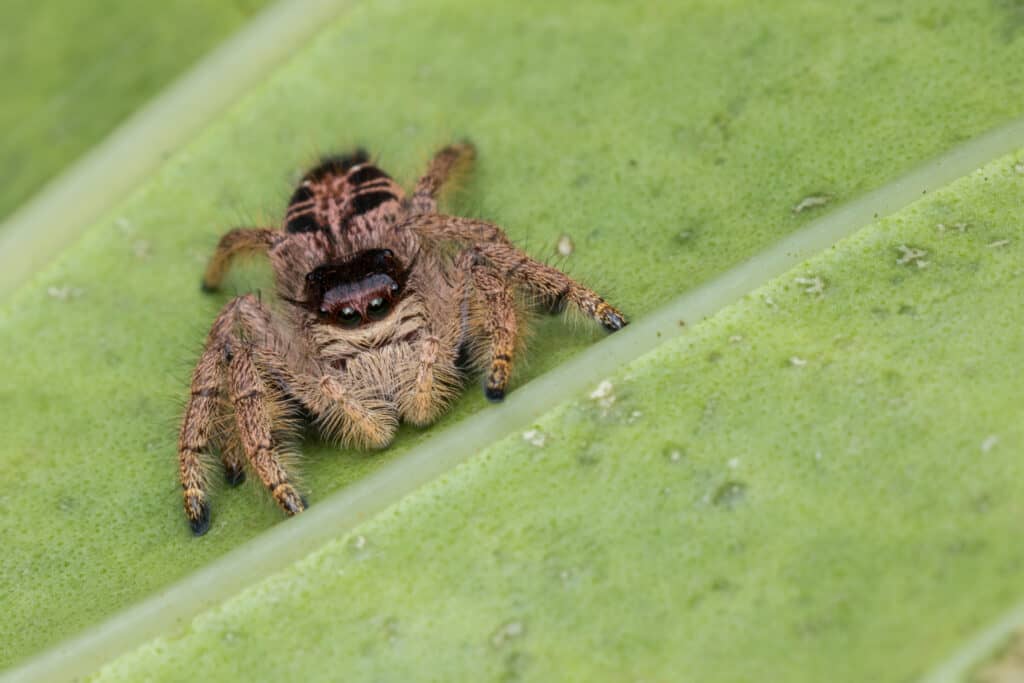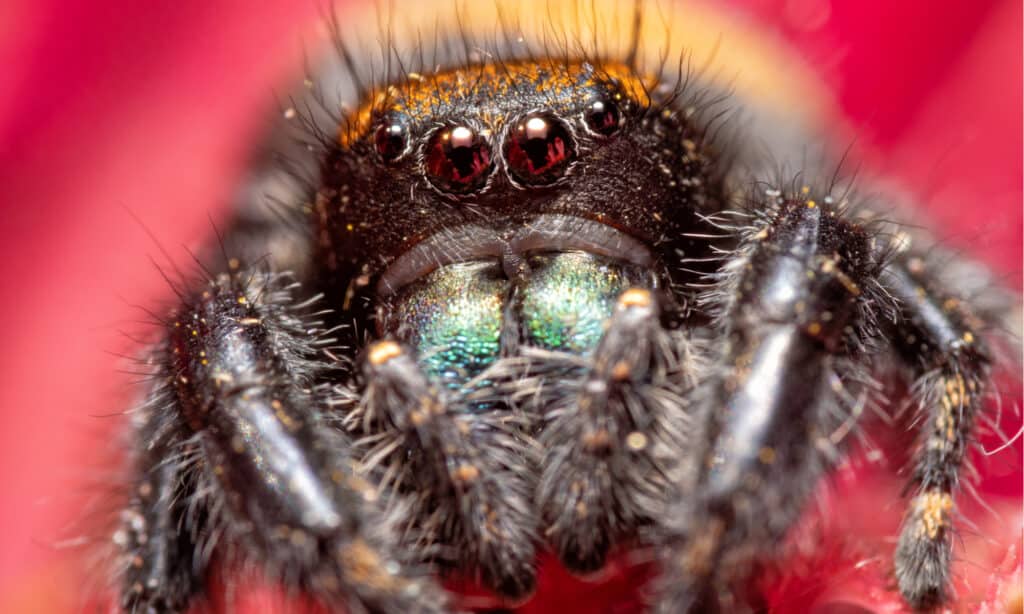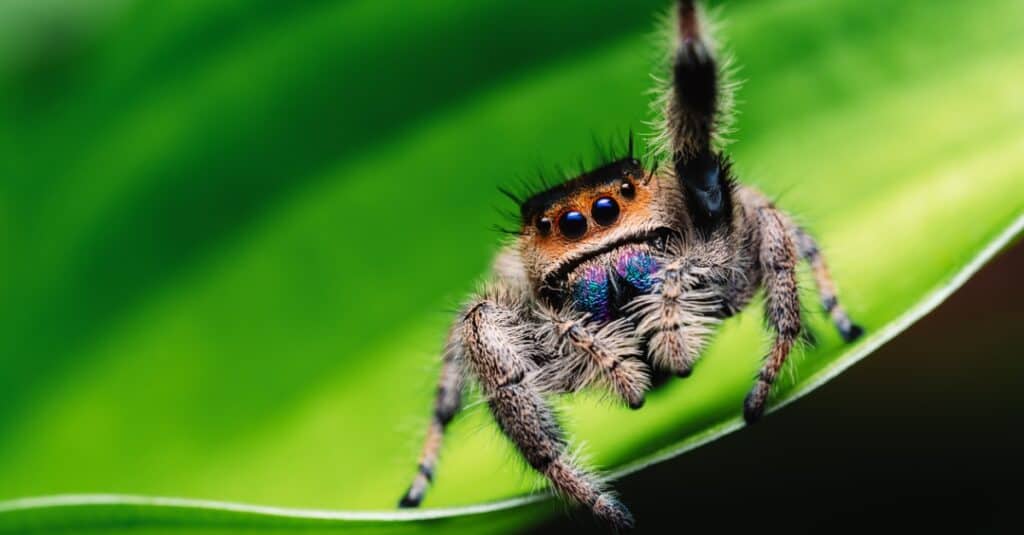
Jumping spiders are a group of small arachnids. Arachnids are a large genus comprising various species of spiders, scorpions, harvestmen, and others. Jumping spiders belong to one of these species, Salticidae. The largest of the jumping spiders is a spider known as Hyllus Giganteus.
These titans of the jumping spider world are also known as giant jumping spiders. It isn’t uncommon for the Hyllus Giganteus to be as long as 0.98 inches. Smaller species range from 0.19 to 0.3 inches.
The First Discovery of the Largest Giant Jumping Spider

The giant jumping spider grows to 0.98 inches, about a third larger than others.
©iStock.com/Thien Woei Jiing
German spider specialist Carl Ludwig Koch discovered the first giant jumping spider in 1846. These spiders are native to Sumatra and Australia, and they live in forests and dwell in trees. Giant jumping spiders do not spin webs like other spiders. Instead, they wander around their forest homes looking for prey, securing their targets by jumping on them.
But don’t become confused between the Hyllus Giganteus and their smaller cousin, Hyllus diardi. Hyllus diardi only reaches a length of 0.59 inches. Other indicators also help identify the world’s largest jumping spider.
Giant Jumping Spiders Have Distinctive Markings
You can differentiate giant jumping spiders from others of the same species. They have distinctive markings and are visibly larger than the smaller species. One identifier for the Hyllus Giganteus is its unique white stripes at the top of its “face.” A black band runs across its head, with two white lines running down its sides. You can also differentiate males and females by their different colors.
The Largest Giant Jumping Spiders Have Various Colors

Female giant jumping spiders are larger than males and both genders have unique color combinations
©Professional Fine Art/Shutterstock.com
Giant jumping spiders come in an assortment of colors, with the males and females often displaying different color combinations. They also have bands across their bodies, making it easy to differentiate between them and other jumping spiders. Female giant jumping spiders are also larger than males. However, the males make up for their lack of size with flashier colors that they are happy to display. Moreover, the male giant jumping spider has a dark body with flamboyant white bands running down its sides.
Male Giant Jumping Spiders Dance To Attract Mates
Male giant jumping spiders dance to attract mates. They sway from side to side and flip their abdomens to show off their vibrant colors. These unique spiders also rub their body parts together and drum on the ground. The drumming keeps the females from losing interest and wandering off.
The male giant jumping spider will try these dances with any female spider regardless of the species. They do this over and over again while searching for the perfect mate. Dancing repeatedly enables the male to improve his chances of finding a mate and to avoid becoming food.
Giant Jumping Spiders Mate In A Special Way

Female jumping spiders watch over their eggs until they hatch.
©iStock.com/Thien Woei Jiing
Male giant jumping spiders use pedipalps to transfer packages of sperm to females. Females will then lay clutches of about 100 eggs. The female spider will protect her eggs until they hatch. Also, the largest female giant jumping spiders only mate once with the male giant jumping spider of her choice. Then, she lays her eggs in a cocoon for three to four weeks. The baby spiders hatch four to six weeks later, leaving the nest soon after.
Giant Jumping Spiders Hunt With Silken Anchors
Giant jumping spiders hunt their prey during daylight hours. These spiders pursue their quarry before leaping on their target to immobilize it. Giant jumping spiders can leap distances of 6,3 inches. They use thin silky “anchors” to protect them in case of a difficult landing. These silk “anchors” also help them while leaping through the air. Some of their favorite prey items include flies, mealworms, other spiders, and even grasshoppers.
These Large Jumping Spiders Have Excellent Eyesight
With eight eyes, one would think that all spiders have excellent vision. However, this isn’t true for all species of spiders. One exception is definitely the giant jumping spider’s pairs of eyes. These spiders have excellent eyesight precisely because they can distinguish between colors.
The Largest Giant Jumping Spiders See In Color

Jumping spiders are small and can be kept in a small container or terrarium.
©Sari ONeal/Shutterstock.com
Scientists believe that giant jumping spiders can see colors and, more precisely, ultraviolet light. They can tell the difference between blue and green and likely between red and orange. This makes it a very unique spider. Hyllus giganteus can also identify different patterns. Spider biologist Nathan Morehouse believes that their eyes have better acuity than elephants. He also explains that having four pairs of eyes increases their hunting abilities.
Largest Eyes Like Binoculars

The jumping spider has a “face” with two binocular-type eyes and others that support peripheral vision.
©iStock.com/Jan Rozehnal
Hyllus Giganteus have a pair of large eyes in the middle of their head. These principal eyes work a lot like binoculars, with the other pairs of eyes surrounding them.
A smaller inner lens in the principles eyes magnifies the image received from the larger outer lens. This enlarged image is then projected onto the retina. Another unusual feature of this pair of eyes is the large muscles attached to the retina. These muscles move the retina up and down to help focus images.
In contrast, the outer pairs of eyes provide Hyllus Giganteus with peripheral vision. The adaptation that allows them to see blue, green, red, and orange also enable them to see in color, one of the few spider species with this ability.
Giant Jumping Spiders Can See Depth
Giant jumping spiders can see depth as well, like others of their species. The eyes of these amazing spiders have developed four layers of photoreceptors, and every layer captures a different color. One study conducted by scientists in 2012 discovered that spider uses these lenses to detect depth.
The Largest Jumping Spiders Are Non-Venomous

Giant jumping spiders are not aggressive and rarely bite people.
©iStock.com/Thien Woei Jiing
While it might be startling to have a giant jumping spider land on you, these creatures aren’t poisonous to people. If one bit you, the worst that should happen is a mild, temporary reaction. Typically, a welt will form that looks like a mosquito bite following a giant jumping spider bite.
Are Giant Jumping Spiders Aggressive?
Giant jumping spiders are not aggressive and rarely bite people. As a matter of fact, they are considered to be easygoing by arachnid enthusiasts and generally safe to handle. But, if you try to crush or threaten this spider, it will defend itself. However, they prefer using their venom to restrain prey like spiders and cockroaches. Scientists classify them as non-harmful to people.
How Long Do Giant Jumping Spiders Live?
Jumping spiders generally live for anywhere between 6 to 24 months. In this case, these large arachnids live a little longer in comparison. Giant jumping spiders will usually live between one to three years.
The photo featured at the top of this post is © Professional Fine Art/Shutterstock.com
Sources
- QuestionAnswer.io, Available here: https://questionanswer.io/are-jumping-spiders-harmful-to-humans/
- Live Science, Available here: https://www.livescience.com/jumping-spiders
- SpiderAnatomy.com , Available here: https://spideranatomy.com/giant-jumping-spider/
- Global Biodiversity Information Facility, Available here: https://www.gbif.org/species/181179680
Thank you for reading! Have some feedback for us? Contact the AZ Animals editorial team.






